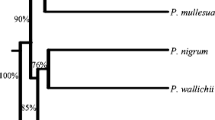Abstract
RAPD analysis of seven samples of fivePorphyra species,P haitanensis (three samples of cultured population),P. katadai var.hemiphylla, P. oligospermatangia, P. suborbiculata andP. yezoensis, showed the closest relationship existing among the three cultured populations ofP. haitanensis. The genetic distance betweenP. haitanensis andP. oligospermatangia was the same as that betweenP. haitanensis andP. suborbiculata, both were 0.9. The genetic distances, among the other species ofPorphyra ranged from 0.7 to 0.8. UPGMA analysis showedP. suborbiculata andP. yezoensis belong to another lineage. Results of this study suggests that RAPD analysis is effective at population level.
Similar content being viewed by others
References
Demeke, T., Adams, R. P., 1994. The use of PCR-RAPD analysis in plant taxonomy and evolution.In: PCR technology, current innovations, Griffin, H. C., Griffin, A. M. (eds). CRC Press, Florida. p. 179–191.
Dutcher, J. A., Kapraun, D. F., 1994. Random amplified polymorpic DNA (RAPD) identification of genetic variation in three species ofPorphyra.J Appl. Phycol. 6: 267–273.
Ho, C. L., Phang, S. M., Pang, T., 1995. Molecular characterisation ofSargassum polycystum andS. siliquosum (Phaeophyta) by polymerase chain reaction (PCR) using random amplified polymorphic DNA (RAPD) primers.J. Appl. Phycol. 7(1): 37–41.
Lu, B. Z., 1993. Construction of evolutionary tree.Zoological Research 14(2): 186–193. (in Chinese)
Patwary, M. U., Mackay, R. M., van der Meer J. P., 1993. Revealing genetic markers inGelidium vagum (Rhodophyta) through the random amplified polymorph DNA (RAPD) technique.J. Phycol. 29:216–22.
Patwary, M. U., van der Meer, J. P., 1994. Application of RAPD markers in an examination, of heterosis inGelidium vagum (Rhodophyta)J. Phycol. 30: 91–97.
Stam, W. T., Olsen, J. L., Van Oppen, M. J. H. et al., 1995. RAPDs and reds: assessing the limits for population level studies J. Phycol. 31 (3): suppl. 14 (Abstract).
Tseng, C. K., Zhang, D. R., Zhang, J. F., 1964. Economic Seaweeds of China, Science Press, Beijing p. 97–108,
Yu, K. F., Pauls, K. P., 1994. Optimization of DNA-extraction and PCR procedures for random amplified polymorphie DNA (RAPD) analysis in plantsIn: PCR technology, Current Innovations, Griffin, H. G., Griffin, A. M. (eds). CRC Press, Florida. p. 193–200.
Author information
Authors and Affiliations
Rights and permissions
About this article
Cite this article
Mei, K., Su-juan, W., Yao, L. et al. RAPD study on some common species ofPorphyra in China. Chin. J. Ocean. Limnol. 16 (Suppl 1), 140–146 (1998). https://doi.org/10.1007/BF02849092
Issue Date:
DOI: https://doi.org/10.1007/BF02849092




